| US PATENT AND TRADEMARK OFFICE | Print This Notice 1397 CNOG 789 |
| Patent Prosecution Highway | Referenced Items (176, 177, 178, 179, 180, 181, 182, 183, 184, 185, 186, 187, 188, 189, 190, 191, 192, 193, 194, 195, 196, 197, 198, 199, 200, 201, 202, 203, 204, 205, 206, 207, 208, 209, 210, 211, 212, 213, 214, 215, 216, 217, 218, 219, 220, 221, 222, 223, 224, 225, 226, 227, 228, 229, 230, 231, 232, 233, 234, 235, 236, 237, 238, 239, 240, 241, 242, 243, 244, 245, 246, 247, 248, 249, 250, 251, 252, 253, 254, 255, 256, 257, 258, 259, 260, 261, 262, 263, 264, 265, 266, 267) |
| (233) |
Notice Regarding Full Implementation of Patent Prosecution Highway Program between the United States Patent and Trademark Office and the Canadian Intellectual Property Office |
I. Background
The United States Patent and Trademark Office (USPTO) has conducted a Patent Prosecution Highway (PPH) pilot program with the Canadian Intellectual Property Office (CIPO) from January 28, 2008, to January 28, 2011. For a complete description of the PPH pilot program, see “Patent Prosecution Highway Pilot Program between the United States Patent and Trademark Office and the Canadian Intellectual Property Office,” published on February 5, 2008, at 1327 OG 45. The results of the pilot program showed that (1) applicants have been able to expeditiously obtain a patent in the Office of second filing (OSF) at an early stage, by utilizing the petition to make special procedures currently available in the OSF, based on claims that have been allowed in the Office of first filing (OFF); (2) the OSF has been able to reduce duplication of search efforts by exploiting the search and examination results of the OFF to a maximum extent practicable; and (3) the OSF has been able to reduce the examination workload since the scope of the claims in the OSF application has been clarified through the OFF’s examination prosecution.
II. Full Implementation of the Patent Prosecution Highway Program
The USPTO and the CIPO agreed to fully implement the PPH program on a permanent basis starting on January 29, 2011.
Note that the procedures for a petition to make special under the accelerated examination program set forth in MPEP 708.02(a) do NOT apply to a PPH request for expedited examination by order of the Director to expedite the business of the Office under 37 CFR 1.102(a). The procedures and requirements for filing a request in the USPTO for participation in the PPH program are set forth below.
A. Requirements for Requesting Participation in the PPH Program in the USPTO
In order to be eligible to participate in the PPH program, the following conditions must be met:
(1) The U.S. application is
(a) a Paris Convention application which either
|
|||||||
| or | |||||||
|
(b) a national stage application under the PCT (an application which entered the national stage in the U.S. from a PCT international application after compliance with 35 U.S.C. 371), which PCT application
|
|||||||
| or | |||||||
|
(c) a so-called bypass application filed under 35 U.S.C. 111(a) which validly claims benefit under 35 U.S.C. 120 to a PCT application, which PCT application
|
Examples of U.S. applications that fall under requirement (1) are:
(1)(a)(i):
- US application with single Paris Convention priority claim to a Canadian (CA) application
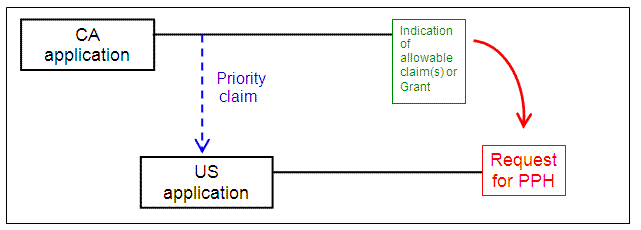
- US application with multiple Paris Convention priority claims to CA applications

- Paris route and domestic priority
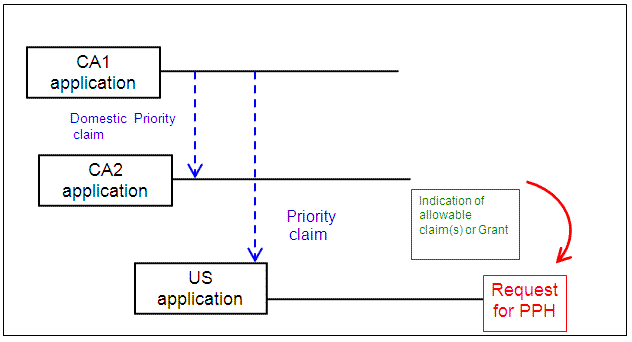
- Paris route and divisional application

(1)(a)(ii):
- US application claims Paris Convention priority to a PCT application
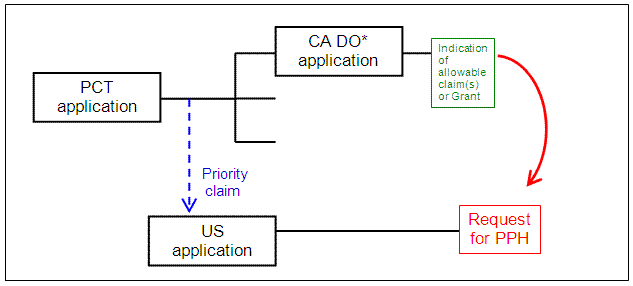
* DO Designated Office
(1)(b)(i):
- US application is a national stage of a PCT application which claims Paris Convention priority to a CA application
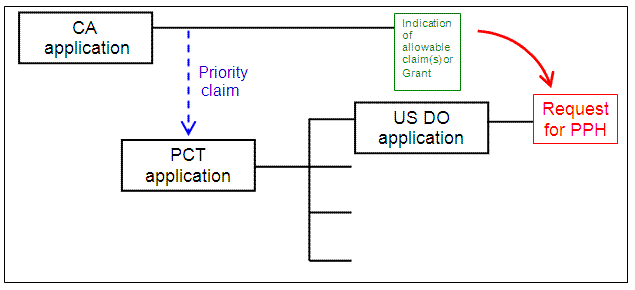
- PCT Route
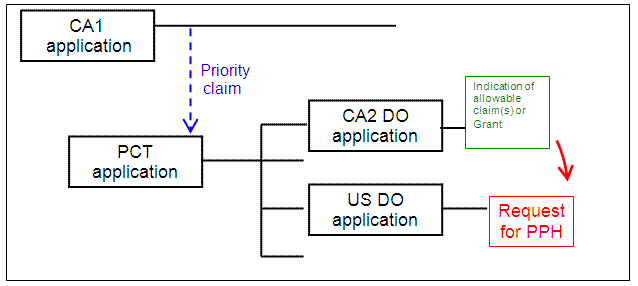
(1)(b)(ii):
- US application is a national stage of a PCT application which claims Paris Convention priority to another PCT application
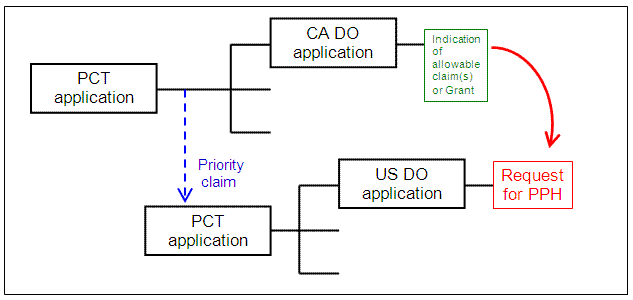
- Direct PCT and PCT Route
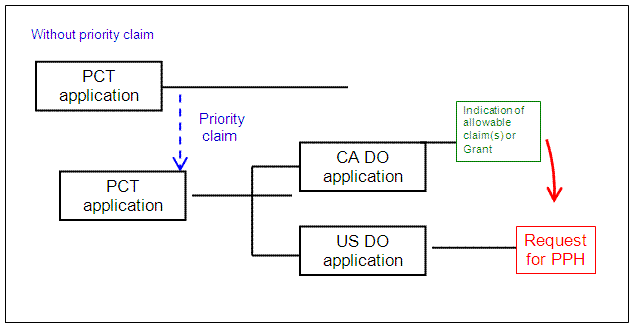
(1)(b)(iii):
- US application is a national stage of a PCT application without priority claim
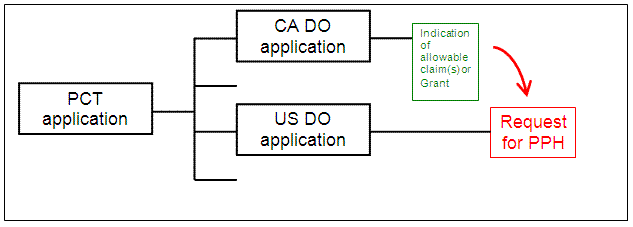
(1)(c)(i):
- US application is a 111(a) bypass of a PCT application which claims Paris Convention priority to a CA application
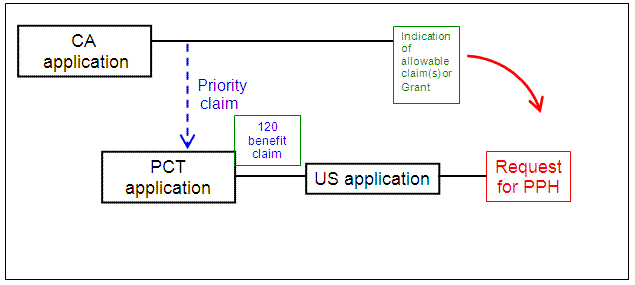
(1)(c)(ii):
- US application is a 111(a) bypass of a PCT application which claims Paris Convention priority to another PCT application
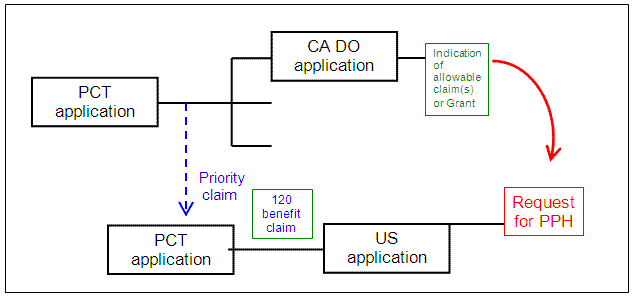
(1)(c)(iii):
- US application is a 111(a) bypass of a PCT application which contains no priority claim

The CA application whose claims are determined to be allowable/patentable does not have to be the application for which priority is claimed in the U.S. application (the basic application). The CA application can be an application explicitly derived from the basic application, e.g., a divisional application of the basic application, a converted application of the basic application or an application which claims domestic priority to the basic application. Note that where the CA application that contains the allowable/patentable claims is not the same application for which priority is claimed in the U.S. application, applicant must identify the relationship between the CA application that contains the allowable/patentable claims and the CA priority application claimed in the U.S. application (e.g., CA application X that contains the allowable/patentable claims, claims domestic priority to CA application Y, which is the priority application claimed in the U.S. application).
Provisional applications, plant and design applications, reissue applications, reexamination proceedings, and applications subject to a secrecy order are excluded and not subject to participation in the PPH program.
(2) The CA application(s) have at least one claim that was determined by the CIPO to be allowable/patentable. Applicant must submit a copy of the allowable/patentable claims from the CA application(s) along with an English translation thereof and a statement that the English translation is accurate if the claims are not in the English language.
(3) All the claims in each U.S. application for which a request for participation in the PPH program is made must sufficiently correspond or be amended to sufficiently correspond to the allowable/patentable claims in the CA application(s). Claims will be considered to sufficiently correspond where, accounting for differences due to translations and claim format requirements, the claims are of the same or similar scope. Applicant is also required to submit a claims correspondence table in English. The claims correspondence table must indicate how all the claims in the U.S. application correspond to the allowable/patentable claims in the CA application(s).
(4) Examination of the U.S. application for which participation in the PPH program is requested has not begun.
(5) Applicant must file a request for participation in the PPH program and a request that the U.S. application be advanced out of turn for examination by order of the Director to expedite the business of the Office under 37 CFR 1.102(a). A sample request form (PTO/SB/20CA) is available at the USPTO Web site at http://www.uspto.gov/patents/init_events/pph/pph_cipo.jsp. Applicants are encouraged to use the USPTO request form. A petition fee under 37 CFR 1.17(h) is NOT required. See Notice Regarding the Elimination of the Fee for Petitions To Make Special Filed Under the Patent Prosecution Highway (PPH) Programs, 75 FR 29312 (May 25, 2010).
(6) Applicant must submit a copy of all the Office actions (which are relevant to patentability) from each of the CA application(s) containing the allowable/patentable claims that are the basis for the request, along with an English translation thereof and a statement that the English translation is accurate if the Office actions are not in the English language. In addition, applicant must submit copies of any Office actions (which are relevant to patentability) from the CA application(s) issued after the grant of the request for participation in the PPH program in the USPTO (especially where CIPO might have reversed a prior holding of allowability).
(7) Applicant must submit an information disclosure statement (IDS) listing the documents cited by the CIPO examiner in the CIPO office action (unless such an IDS has already been filed in the U.S. application). Applicant must submit copies of all the documents cited in the CIPO office action (unless the copies have already been filed in the U.S. application) except U.S. patents or U.S. patent application publications.
The request for participation in the PPH program and all the supporting documents must be submitted to the USPTO via EFS-Web and indexed with the following document description: “Petition to make special under Patent Pros Hwy.” Information regarding EFS-Web is available at http://www.ustpo.gov/ebc/efs_help.html. Any preliminary amendments and IDS submitted with the PPH documents must be separately indexed as a preliminary amendment and IDS, respectively.
Where the request for participation in the PPH program and special status are granted, applicant will be notified and the U.S. application will be advanced out of turn for examination. In those instances where the request for participation in the PPH program does not meet all the requirements set forth above, applicant will be notified and the defects in the request will be identified. Applicant will be given one opportunity to perfect the request in a renewed request for participation (which must be submitted via EFS-Web and indexed accordingly as noted above). Note that action on the application by the examiner will NOT be suspended (37 CFR 1.103) awaiting a reply by the applicant to perfect the request in a renewed request for participation. That is, if the application is picked up for examination by the examiner after applicant has been notified of the defects in the request, any renewed request will be dismissed. If the renewed request is perfected and examination has not begun, the request and special status will be granted, applicant will be notified and the U.S. application will be advanced out of turn for examination. If not perfected, applicant will be notified and the application will await action in its regular turn.
(8) Request for participation in the PPH program and special status granted in a parent application will not carry over to a continuing application. Continuing applications must separately fulfill the conditions set forth above.
If any of the documents identified in items (2), (6) and (7) above have already been filed in the U.S. application prior to the request for participation in the PPH program, it will not be necessary for applicant to resubmit these documents with the request for participation. Applicant may simply refer to these documents and indicate in the request for participation in the PPH program when these documents were previously filed in the U.S. application.
B. Special Examining Procedures
Once the request for participation in the PPH program and special status have been granted to the U.S. application, the U.S. application will be taken up for examination by the U.S. examiner before all other categories of applications except those clearly in condition for allowance, those with set time limits, such as examiner’s answers, and those that have been granted special status for “accelerated examination.”
Any claims amended or added after the grant of the request for participation in the PPH program must sufficiently correspond to one or more allowable/patentable claims in the CA application(s). Applicant is required to submit a claims correspondence table along with the amendment (see A.(3) above). If the amended or newly added claims do not sufficiently correspond to the allowable/patentable claims in the CA application(s), the amendment will not be entered and will be treated as a non-responsive reply.
The PPH program does not absolve applicants of all their duties under 37 CFR 1.56 and 37 CFR 11.18. By complying with requirements A.(6) and (7) identified above, applicants would be considered to have complied with their duties to bring to the attention of the USPTO any material prior art cited in the corresponding foreign application(s) (see MPEP § 2001.06(a)). Applicants still have a duty of candor and good faith, including providing to the USPTO other information known to them to be material to patentability.
Any inquiries concerning this notice may be directed to Magdalen Greenlief, Office of the Associate Commissioner for Patent Examination Policy, at 571-272-8140, or at magdalen.greenlief@uspto.gov.
| DAVID J. KAPPOS | |
| Under Secretary of Commerce for Intellectual Property and | |
| Director of the United States Patent and Trademark Office |
| [1363 OG 104] |